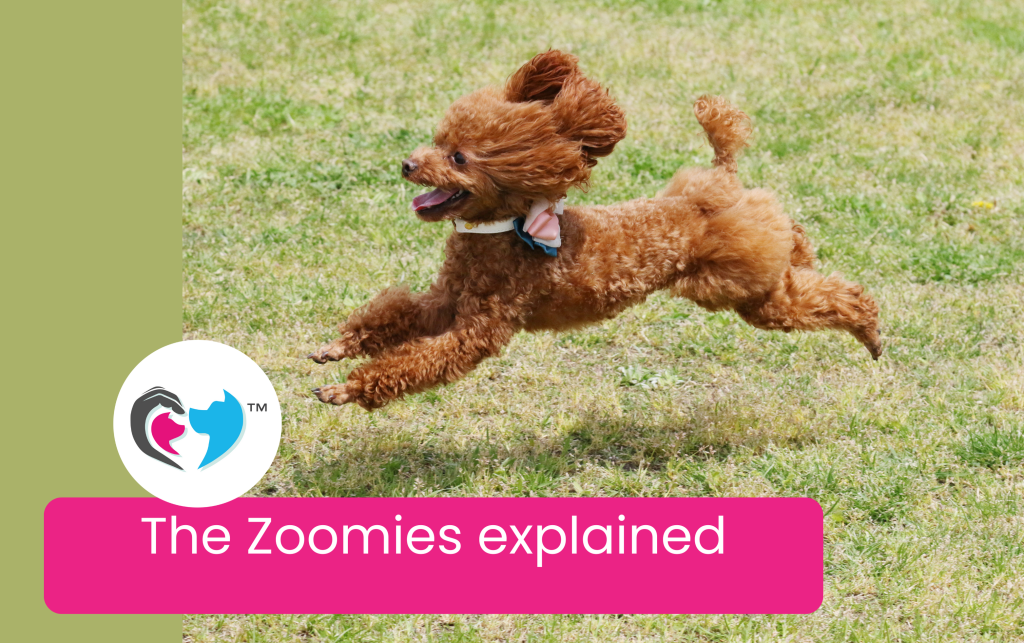

If you’ve ever seen your dog suddenly burst into a high-speed sprint around the house or garden with tail tucked, eyes wild, body twisting with joy, you’ve witnessed what’s fondly known as “the zoomies.” Technically termed Frenetic Random Activity Periods (FRAPs), these explosive bursts of energy are both fascinating and amusing. But why do they happen?
As an animal behaviourist, I often get asked if zoomies are a sign of stress, misbehaviour, or simply joy. The short answer is: It depends. Let’s explore the causes, contexts, and considerations behind this quirky canine behaviour.
What are the zoomies?
Zoomies are short-lived bursts of intense activity, where a dog runs, spins, or dashes back and forth for no apparent reason. They typically last from a few seconds to a couple of minutes and are more common in puppies and young dogs, but can happen at any age.
These FRAPs are completely normal and generally harmless, provided they occur in a safe environment (Overall, 2013).
Why do dogs get the zoomies?
1. Energy release
The most common cause of zoomies is pent-up energy. Dogs who haven’t had enough physical exercise or mental stimulation may “blow off steam” through spontaneous sprints.
“Zoomies are a dog’s way of regulating arousal and releasing energy that might otherwise be expressed in undesirable ways, such as destructive behaviour or excessive barking” (Horwitz & Mills, 2009).
2. Emotional release (Joy, Relief, or Stress)
Dogs often zoom after:
FRAPs can follow a stress-inducing event—like grooming, a vet visit, or restraint—as a way to shake off the experience.
3. Developmental stage
Puppies are especially prone to zoomies because their brains are still developing impulse control. What looks wild and chaotic is often just normal puppy behaviour.
“FRAPs are particularly common in juveniles as part of their exploratory and play-based learning process” (Overall, 2013).
4. Social facilitation
Sometimes zoomies are socially contagious. One dog runs, and another follows, turning into a wild game of chase. This is often seen in group settings like dog parks or multi-dog households.
Are zoomies a problem?
Usually, no. Zoomies are a healthy and natural expression of excitement or release. However, some situations may call for closer observation:
How to support your dog’s need for FRAPs?
✔️ Provide daily physical & mental enrichment
Regular walks, training sessions, scent games, and puzzle feeders reduce the need for stress-relief zoomies.
✔️ Allow safe spaces for zooming
Use a secure garden or open space where your dog can run freely and safely.
✔️ Avoid punishment
Never scold a dog for having the zoomies. Instead, try to anticipate and redirect if the environment isn’t safe.
✔️ Rule out medical issues
Sudden, frantic behaviour can very rarely be due to discomfort, allergies, or neurological conditions. If zoomies are extreme, repetitive, or accompanied by distress signs (panting, drooling, biting tail), consult a vet.
Zoomies are a joyful, functional, and natural part of many dogs’ lives. They help regulate emotion, release energy, and often serve as a form of self-soothing or excitement expression.
As long as they happen in a safe space and aren’t displacing deeper behavioural issues, zoomies are not only normal, they’re something to celebrate.
So, the next time your dog goes zooming across the yard in a blur of fur and paws, smile. You’re witnessing your pet’s version of sheer delight.
References